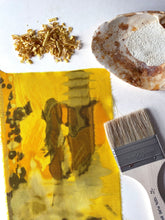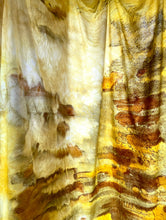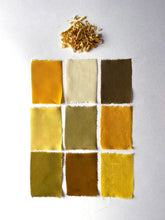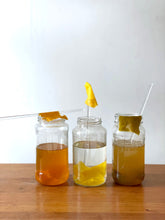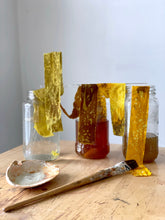
Pre-recorded workshop:
In this workshop, I share a unique approach that I have developed for working with pH modifiers and metal salts on naturally dyed fabrics. By using my techniques, you can create painterly compositions and extend the color range of a single dye material in innovative ways on your various dye projects.
Beginners are welcome. I share extensive information on how to thoroughly execute the scouring, mordanting, and dyeing processes on various fiber types, prior to modifying color to ensure the best outcome.
With your purchase you will receive:
- 2 pre-recorded sessions (each session is about 2hr)
- additional hand outs + resources on the natural dye process, where to get materials and supplies, recipes, and more
This recorded workshop focuses on osage orange - a gorgeous yellow dye from the heartwood of the osage orange tree, a species that is native to the United States. However, the process and techniques we discuss can be applied to any naturally dyed base color.
***Please download the materials as soon as you receive them, as the link expires in 24 hours***
Some items you will need to have on hand:
-heat (stovetop or hotplates)
-water (sink/bathtub/stream)
-pots (stainless steel or enamel, recommend 2-3)
-spoons/stirring tools
-oven mitts (for handling hot objects)
-drop cloth(s) for covering workspace
-face mask (for when we dissolve mordants)
-tea kettle for boiling water (or another small pot dedicated for this)
-3 glass jars (approx 16oz size, or bigger)
-2-3 rinse/soak buckets (approx 2 gallon size)
-scissors
-paintbrushes (various sizes and bristles are great for creating texture)
-rubber bands
-strainer (stainless steel & one that can rest on top of your pot unassisted- for steaming bundles)
Set up and safety:
-Wear clothes and shoes you don't mind staining - may get messy!
-You will need access to water + heat sources (stove top or hot plates). I recommend setting up in your kitchen near stove, or outdoor space with hot plates.
-Recommend covering your workspace in drop cloth (floor, table space, etc). Make sure it is taped down and secure so you do not slip! (sometimes I cut & spread open large trash bags and use these to cover my floor)
-You should use dye-dedicated tools. Although natural, not all materials are safe for humans to ingest. We are not working with anything toxic, but it is best to err on the safe side! Ex. maybe don't use your favorite pot for cooking pasta




